How Does the World View China’s Carbon Policy? A Sentiment Analysis on Twitter Data
Abstract
:1. Introduction
2. Data and Methods
2.1. Data Description
2.2. Data Preprocessing
2.3. Sentiment Analysis
2.4. Word Cloud
2.5. Multiple Regression Model
3. Results
3.1. Inter- and Intra-Annual Trend in the Count of Tweets about China’s Carbon Policy
3.2. Sentiment Analysis for China Carbon Policy Tweets
3.3. Top Frequency Words (Positive, Negative, Neutral) for China Carbon Policy Tweets
3.4. Twitter Location Analysis
3.5. Impact of China’s Official Twitter Accounts
4. Discussion
5. Conclusions
- (1)
- The global attention to China’s carbon policy is gradually increasing but is found to exhibit sudden spikes due to the occurrence of some important carbon-newsworthy events. Furthermore, the average count increases approximately 46.11 times each year. The maximum counts of tweets about China’s carbon policy exceed 3000 per day in 2014, 2015, 2016, 2017, and 2021, which are all related to important carbon events.
- (2)
- From 2008 to 2020, inferred positive and negative attitudes increase by approximately 0.35%/year and 0.96%/year, respectively, and the rate of decrease for neutral attitudes is approximately 1.31%/yr. The proportion of tweets with negative sentiment about China’s carbon policy has increased rapidly and recently exceeded the proportion of tweets with positive sentiment. Therefore, the Chinese government may need to monitor and understand the impact of the increasing negative evaluation of China’s carbon policy on China’s image and take more practical actions to reduce carbon emissions.
- (3)
- People who hold positive attitudes are concerned about reducing carbon emissions and important carbon events, and people who hold negative attitudes tend to be associated with negative words and polluted environment vocabularies. No special high-frequency words appear in the discussions of people with neutral attitudes.
- (4)
- People in different countries have different attitudes towards China’s carbon policy. Generally speaking, the developed countries led by the United States may hold a negative attitude towards China’s carbon policy because of ideology and other reasons. People in developing countries generally hold either a more positive or neutral attitude towards China’s carbon policy. This shows that the Chinese government can unite more developing countries and win the support of developing countries to deal with the pressure of developed countries on the issue of climate change.
- (5)
- Tweets sent from China’s official diplomatic Twitter account do help to enhance China’s good image. In order to maintain China’s image as a responsible great power and reduce the negative global perceptions of China, it may be particularly important to give full play to the influence of China’s official social media accounts.
Author Contributions
Funding
Data Availability Statement
Acknowledgments
Conflicts of Interest
References
- Qi, X.; Han, Y. Energy quota trading can achieve energy savings and emission reduction: Evidence from China’s pilots. Environ. Sci. Pollut. Res. Int. 2021, 28, 52431–52458. [Google Scholar] [CrossRef]
- Liu, L.; Chen, C.; Zhao, Y.; Zhao, E. China’s carbon-emissions trading: Overview, challenges and future. Renew. Sustain. Energy Rev. 2015, 49, 254–266. [Google Scholar] [CrossRef]
- Qi, X.; Han, Y. How Carbon Trading Reduces China’s Pilot Emissions: An Exploration Combining LMDI Decomposition and Synthetic Control Methods. Pol. J. Environ. Stud. 2020, 29, 3273–3284. [Google Scholar] [CrossRef]
- Gao, Y.; Li, M.; Xue, J.; Liu, Y. Evaluation of effectiveness of China’s carbon emissions trading scheme in carbon mitigation—ScienceDirect. Energy Econ. 2020, 90, 104872. [Google Scholar] [CrossRef]
- Zhang, S.; Chen, L.; Zheng, Y.; Li, Y.; Li, Y.; Zeng, M. How Policies Guide and Promoted Wind Power to Market Transactions in China during the 2010s. Energies 2021, 14, 4096. [Google Scholar] [CrossRef]
- Duan, H.; Zhou, S.; Jiang, K.; Bertram, C.; Harmsen, M.; Kriegler, E.; van Vuuren, D.P.; Wang, S.; Fujimori, S.; Tavoni, M. Assessing China’s efforts to pursue the 1.5 degrees C warming limit. Science 2021, 372, 378–385. [Google Scholar] [CrossRef] [PubMed]
- Chen, J.; Cui, H.; Xu, Y.; Ge, Q. Long-term temperature and sea-level rise stabilization before and beyond 2100: Estimating the additional climate mitigation contribution from China’s recent 2060 carbon neutrality pledge. Environ. Res. Lett. 2021, 16, 074032. [Google Scholar] [CrossRef]
- Tracker, C.A. China Going Carbon Neutral before 2060 Would Lower Warming Projections by around 0.2 to 0.3 Degrees C. Available online: https://climateactiontracker.org/press/china-carbon-neutral-before-2060-would-lower-warming-projections-by-around-2-to-3-tenths-of-a-degree/ (accessed on 23 September 2020).
- Tracker, C.A. The CAT Thermometer. Available online: https://climateactiontracker.org/global/cat-thermometer/ (accessed on 4 May 2021).
- Mallapaty, S. How China could be carbon neutral by mid-century. Nature 2020, 586, 482–483. [Google Scholar] [CrossRef]
- Wang, Z.; Zhu, Y.; Zhu, Y.; Shi, Y. Energy structure change and carbon emission trends in China. Energy 2016, 115, 369–377. [Google Scholar] [CrossRef]
- Lin, B.; Moubarak, M. Renewable energy consumption—Economic growth nexus for China. Renew. Sustain. Energy Rev. 2014, 40, 111–117. [Google Scholar] [CrossRef]
- Pata, U.K.; Caglar, A.E. Investigating the EKC hypothesis with renewable energy consumption, human capital, globalization and trade openness for China: Evidence from augmented ARDL approach with a structural break. Energy 2021, 216, 119220. [Google Scholar] [CrossRef]
- Zheng, H.; Song, M.; Shen, Z. The evolution of renewable energy and its impact on carbon reduction in China. Energy 2021, 237, 121639. [Google Scholar] [CrossRef]
- Xu, G.; Schwarz, P.; Yang, H. Adjusting energy consumption structure to achieve China’s CO2 emissions peak. Renew. Sustain. Energy Rev. 2020, 122, 109737. [Google Scholar] [CrossRef]
- Davidson, M.; Karplus, V.J.; Zhang, D.; Zhang, X. Policies and Institutions to Support Carbon Neutrality in China by 2060. Econ. Energy Environ. Policy 2021, 10, 7–24. [Google Scholar] [CrossRef]
- Mi, Z.; Wei, Y.-M.; Wang, B.; Meng, J.; Liu, Z.; Shan, Y.; Liu, J.; Guan, D. Socioeconomic impact assessment of China’s CO2 emissions peak prior to 2030. J. Clean. Prod. 2017, 142, 2227–2236. [Google Scholar] [CrossRef] [Green Version]
- Weng, Y.; Cai, W.; Wang, C. Evaluating the use of BECCS and afforestation under China’s carbon-neutral target for 2060. Appl. Energy 2021, 299, 117263. [Google Scholar] [CrossRef]
- Ding, S.; Zhang, M.; Song, Y. Exploring China’s carbon emissions peak for different carbon tax scenarios. Energy Policy 2019, 129, 1245–1252. [Google Scholar] [CrossRef]
- McGrath, M. Climate Change: China Aims for ‘Carbon Neutrality by 2060′. Available online: https://www.bbc.com/news/science-environment-54256826 (accessed on 22 September 2020).
- García-Herrero, A.; Tagliapietra, S. China Has a Grand Carbon Neutrality Target but Where Is the Plan? Available online: https://www.bruegel.org/2021/04/chinas-has-a-grand-carbon-neutrality-target-but-where-is-the-plan/ (accessed on 14 April 2021).
- Press, T.A. China, Top Global Emitter, Aims to Go Carbon-Neutral by 2060. Available online: https://apnews.com/article/climate-climate-change-paris-xi-jinping-emissions-reduction-7a4216ad4026090adb8d600fab210406 (accessed on 23 September 2020).
- Myers, S.L. China’s Pledge to Be Carbon Neutral by 2060: What It Means. Available online: https://www.nytimes.com/2020/09/23/world/asia/china-climate-change.html (accessed on 23 September 2020).
- Economist. China’s Climate Sincerity Is Being Put to the Test. Available online: https://www.economist.com/china/2021/06/17/chinas-climate-sincerity-is-being-put-to-the-test (accessed on 17 June 2021).
- Soo, Z. China Sticks to Goal of Having Carbon Emissions Peak by 2030. Available online: https://apnews.com/article/europe-business-china-environment-and-nature-climate-change-7e29d68ea8a77ee8ebbe1460f0f09ffd (accessed on 3 August 2021).
- Tracker, T.C.A. China Overall Rating. Available online: https://climateactiontracker.org/countries/china/ (accessed on 15 September 2021).
- Wang, J. Managing national reputation and international relations in the global era: Public diplomacy revisited. Public Relat. Rev. 2006, 32, 91–96. [Google Scholar] [CrossRef]
- Buhmann, A.; Ingenhoff, D. Advancing the country image construct from a public relations perspective: From model to measurement. J. Commun. Manag. 2015, 19, 62–80. [Google Scholar] [CrossRef] [Green Version]
- Yang, M.; Wan, H. The Influence of Social Media on the Design of the National Image in the Globalization Context. In Proceedings of the Social Computing and Social Media, Toronto, ON, Canada, 17–22 July 2016; Lecture Notes in Computer Science. Springer: Cham, Switzerland, 2016; pp. 234–246. [Google Scholar]
- Bosch, T. Blogging and tweeting climate change in South Africa. Ecquid Novi Afr. J. Stud. 2012, 33, 44–53. [Google Scholar] [CrossRef]
- Gottfried, J.; Shearer, E. News Use across Social Media Platforms 2016; Pew Research Center: Washington, DC, USA, 2016. [Google Scholar]
- Lück, J.; Wozniak, A.; Wessler, H. Networks of Coproduction: How Mainstream NGOs and Journalists Create Common Interpretations of the UN Climate Summits. Int. J. Press Politics 2015, 21, 25–47. [Google Scholar] [CrossRef] [Green Version]
- Anderson, A. Sources, media, and modes of climate change communication: The role of celebrities. WIREs Clim. Chang. 2011, 2, 535–546. [Google Scholar] [CrossRef]
- Jang, S.M.; Hart, P.S. Polarized frames on ‘‘climate change’’ and ‘‘global warming’’ across countries and states: Evidence from Twitter big data. Glob. Environ. Chang. 2015, 32, 11–17. [Google Scholar] [CrossRef]
- Schuldt, J.P.; Enns, P.K.; Cavaliere, V. Does the label really matter? Evidence that the US public continues to doubt “global warming” more than “climate change”. Clim. Chang. 2017, 143, 271–280. [Google Scholar] [CrossRef]
- Pathak, N.; Henry, M.J.; Volkova, S. Understanding Social Media’s Take on Climate Change through Large-Scale Analysis of Targeted Opinions and Emotions. In 2017 AAAI Spring Symposium Series; Aaai Press: Palo Alto, CA, USA, 2017. [Google Scholar]
- Cody, E.M.; Reagan, A.J.; Mitchell, L.; Dodds, P.S.; Danforth, C.M. Climate Change Sentiment on Twitter: An Unsolicited Public Opinion Poll. PLoS ONE 2015, 10, e0136092. [Google Scholar] [CrossRef] [Green Version]
- Veltri, G.A.; Atanasova, D. Climate change on Twitter: Content, media ecology and information sharing behaviour. Public Underst. Sci. 2017, 26, 721–737. [Google Scholar] [CrossRef]
- Baylis, P. Temperature and temperament: Evidence from Twitter. J. Public Econ. 2020, 184, 104161. [Google Scholar] [CrossRef]
- Berglez, P.; Al-Saqaf, W. Extreme weather and climate change: Social media results, 2008–2017. Environ. Hazards 2021, 20, 382–399. [Google Scholar] [CrossRef]
- Kirilenko, A.P.; Molodtsova, T.; Stepchenkova, S.O. People as sensors: Mass media and local temperature influence climate change discussion on Twitter. Glob. Environ. Chang. 2015, 30, 92–100. [Google Scholar] [CrossRef]
- Abbar, S.; Zanouda, T.; Berti-Equille, L.; Borge-Holthoefer, J. Using Twitter to Understand Public Interest in Climate Change: The Case of Qatar. In Proceedings of the Tenth International AAAI Conference on Web and Social Media, Cologne, Germany, 17–20 May 2016. [Google Scholar]
- Sisco, M.R.; Bosetti, V.; Weber, E.U. When do extreme weather events generate attention to climate change? Clim. Chang. 2017, 143, 227–241. [Google Scholar] [CrossRef]
- Kirilenko, A.P.; Stepchenkova, S.O. Public microblogging on climate change: One year of Twitter worldwide. Glob. Environ. Chang. 2014, 26, 171–182. [Google Scholar] [CrossRef]
- Verma, I.M. Editorial Expression of Concern: Experimental evidence of massivescale emotional contagion through social networks. Proc. Natl. Acad. Sci. USA 2014, 111, 10779. [Google Scholar] [CrossRef] [PubMed] [Green Version]
- Margolin, D.; Liao, W. The emotional antecedents of solidarity in social media crowds. New Media Soc. 2018, 20, 3700–3719. [Google Scholar] [CrossRef] [Green Version]
- Brady, W.J.; Wills, J.A.; Jost, J.T.; Tucker, J.A.; Van Bavel, J.J. Emotion shapes the diffusion of moralized content in social networks. Proc. Natl. Acad. Sci. USA 2017, 114, 7313–7318. [Google Scholar] [CrossRef] [Green Version]
- Priyadarshini, I.; Mohanty, P.; Kumar, R.; Sharma, R.; Puri, V.; Singh, P.K. A study on the sentiments and psychology of twitter users during COVID-19 lockdown period. Multimed. Tools Appl. 2021, 1–23. [Google Scholar] [CrossRef] [PubMed]
- Zhang, C.; Yu, M.C.; Marin, S. Exploring public sentiment on enforced remote work during COVID-19. J. Appl. Psychol. 2021, 106, 797–810. [Google Scholar] [CrossRef]
- Cabezas, J.; Moctezuma, D.; Fernandez-Isabel, A.; Martin de Diego, I. Detecting Emotional Evolution on Twitter during the COVID-19 Pandemic Using Text Analysis. Int. J. Environ. Res. Public Health 2021, 18, 6981. [Google Scholar] [CrossRef] [PubMed]
- Medhat, W.; Hassan, A.; Korashy, H. Sentiment analysis algorithms and applications: A survey. Ain Shams Eng. J. 2014, 5, 1093–1113. [Google Scholar] [CrossRef] [Green Version]
- Chaudhry, H.N.; Javed, Y.; Kulsoom, F.; Mehmood, Z.; Khan, Z.I.; Shoaib, U.; Janjua, S.H. Sentiment Analysis of before and after Elections: Twitter Data of U.S. Election 2020. Electronics 2021, 10, 2082. [Google Scholar] [CrossRef]
- Chauhan, P.; Sharma, N.; Sikka, G. The emergence of social media data and sentiment analysis in election prediction. J. Ambient. Intell. Humaniz. Comput. 2021, 12, 2601–2627. [Google Scholar] [CrossRef]
- Dandannavar, P.S.; Mangalwede, S.R.; Deshpande, S.B. Emoticons and Their Effects on Sentiment Analysis of Twitter Data. In Proceedings of the EAI International Conference on Big Data Innovation for Sustainable Cognitive Computing, Coimbatore, India, 17–18 December 2020; pp. 191–201. [Google Scholar] [CrossRef]
- Faizi, R.; El Fkihi, S.; Ezzahid, S.S.; El Afia, A. Using Sentiment Analysis to Derive Business Value. In Proceedings of the 32nd Conference of the International-Business-Information-Management-Association (IBIMA), Seville, Spain, 15–16 November 2018; pp. 6781–6785. [Google Scholar]
- Naseem, U.; Razzak, I.; Khushi, M.; Eklund, P.W.; Kim, J. A Large-Scale Benchmark Twitter Data Set for COVID-19 Sentiment Analysis. IEEE Trans. Comput. Soc. Syst. 2021, 8, 1003–1015. [Google Scholar] [CrossRef]
- Huang, Z.; Arifon, O. Chinese public diplomacy on Twitter: Creating a harmonious polyphony. Hermès La Rev. 2018, 81, 45–53. [Google Scholar] [CrossRef]
- Huang, Z.A.; Wang, R. Building a Network to “Tell China Stories Well”: Chinese Diplomatic Communication Strategies on Twitter. Int. J. Commun. 2019, 13, 2984–3007. [Google Scholar]
- Zhao, J.; Gui, X. Comparison Research on Text Pre-processing Methods on Twitter Sentiment Analysis. IEEE Access 2017, 5, 2870–2879. [Google Scholar] [CrossRef]
- Saif, H.; He, Y.; Fernandez, M.; Alani, H. Semantic Patterns for Sentiment Analysis of Twitter. In Proceedings of the International Semantic Web Conference, Riva del Garda, Italy, 19–23 October 2014; Volume 8797, pp. 324–340. [Google Scholar] [CrossRef]
- Terrana, D.; Augello, A.; Pilato, G. Automatic Unsupervised Polarity Detection on a Twitter Data Stream. In Proceedings of the 2014 IEEE International Conference on Semantic Computing (ICSC), Newport Beach, CA, USA, 16–18 June 2014; pp. 128–134. [Google Scholar] [CrossRef]
- Saif, H.; Fernandez, M.; He, Y.; Alani, H. On Stopwords, Filtering and Data Sparsity for Sentiment Analysis of Twitter. In Proceedings of the LREC 2014—9th International Conference on Language Resources and Evaluation, Reykjavik, Iceland, 26–31 May 2014; pp. 810–817. [Google Scholar]
- Sattar, N.S.; Arifuzzaman, S. COVID-19 Vaccination Awareness and Aftermath: Public Sentiment Analysis on Twitter Data and Vaccinated Population Prediction in the USA. Appl. Sci. 2021, 11, 6128. [Google Scholar] [CrossRef]
- Hutto, C.; Gilbert, E. VADER: A Parsimonious Rule-based Model for Sentiment Analysis of Social Media Text. In Proceedings of the International AAAI Conference on Web and Social Media, Ann Arbor, MI, USA, 1–4 June 2014; Volume 8, pp. 216–225. [Google Scholar]
- Ribeiro, F.N.; Araújo, M.; Gonçalves, P.; André Gonçalves, M.; Benevenuto, F. SentiBench—A benchmark comparison of state-of-the-practice sentiment analysis methods. EPJ Data Sci. 2016, 5, 1–29. [Google Scholar] [CrossRef] [Green Version]
- Zunic, A.; Corcoran, P.; Spasic, I. Sentiment Analysis in Health and Well-Being: Systematic Review. JMIR Med. Inform. 2020, 8, e16023. [Google Scholar] [CrossRef] [PubMed]
- Fan, R.; Varol, O.; Varamesh, A.; Barron, A.; van de Leemput, I.A.; Scheffer, M.; Bollen, J. The minute-scale dynamics of online emotions reveal the effects of affect labeling. Nat. Hum. Behav. 2018, 3, 92–100. [Google Scholar] [CrossRef]
- Zheng, J.; Mi, Z.; Coffman, D.M.; Milcheva, S.; Shan, Y.; Guan, D.; Wang, S. Regional development and carbon emissions in China. Energy Econ. 2019, 81, 25–36. [Google Scholar] [CrossRef]
- Shahin, S.; Huang, Q.E. Friend, Ally, or Rival? Twitter Diplomacy as “Technosocial” Performance of National Identity. Int. J. Commun. 2019, 13, 5100–5118. [Google Scholar]
- Wang, A.H.-E.; Lee, M.-C.; Wu, M.-H.; Shen, P. Influencing overseas Chinese by tweets: Text-images as the key tactic of Chinese propaganda. J. Comput. Soc. Sci. 2020, 3, 469–486. [Google Scholar] [CrossRef] [PubMed]
- Liss, A. Images of China in the American Print Media: A survey from 2000 to 2002. J. Contemp. China 2003, 12, 299–318. [Google Scholar] [CrossRef]
- Peng, Z. Representation of China: An across time analysis of coverage in the New York Times and Los Angeles Times. Asian J. Commun. 2004, 14, 53–67. [Google Scholar] [CrossRef]
- Tang, L. Transitive representations of China’s image in the US mainstream newspapers: A corpus-based critical discourse analysis. Journalism 2018, 22, 804–820. [Google Scholar] [CrossRef]
- Carraro, C.; Siniscalco, D. The international dimension of environmental policy. Eur. Econ. Rev. 1992, 36, 379–387. [Google Scholar] [CrossRef]
- Li, B.; Xu, Z. China’s Self-identity Construction as a Responsible Power in the Post-cold War Era. Teach. Res. 2006, 1, 49–56. [Google Scholar]
- Tom, L. Whither China: From membership to responsibility? NBR Anal. 2005, 16, 5–14. [Google Scholar]
- Xie, T.; Page, B.I. What Affects China’s National Image? A cross-national study of public opinion. J. Contemp. China 2013, 22, 850–867. [Google Scholar] [CrossRef]
- Aldrich, J.; Lu, J.; Kang, L. How Do Americans View the Rising China? J. Contemp. China 2014, 24, 203–221. [Google Scholar] [CrossRef]
- Kang, L.; Chu, Y.-H. China’s Rise through World Public Opinion: Editorial Introduction. J. Contemp. China 2014, 24, 197–202. [Google Scholar] [CrossRef]
- Chu, Y.-H.; Kang, L.; Huang, M.-H. How East Asians View the Rise of China. J. Contemp. China 2014, 24, 398–420. [Google Scholar] [CrossRef]
- Kušen, E.; Strembeck, M. Something draws near, I can feel it: An analysis of human and bot emotion-exchange motifs on Twitter. Online Soc. Netw. Media 2019, 10, 1–17. [Google Scholar] [CrossRef]
- Kušen, E.; Strembeck, M. “Evacuate everyone south of that line” Analyzing structural communication patterns during natural disasters. J. Comput. Soc. Sci. 2020, 4, 531–565. [Google Scholar] [CrossRef]
- Wojcik, S.; Hughes, A. Sizing up Twitter Users; Pew Research Center: Washington, DC, USA, 2019. [Google Scholar]
- Xu, H.; Zhang, N.; Zhou, L. Validity Concerns in Research Using Organic Data. J. Manag. 2020, 46, 1257–1274. [Google Scholar] [CrossRef]
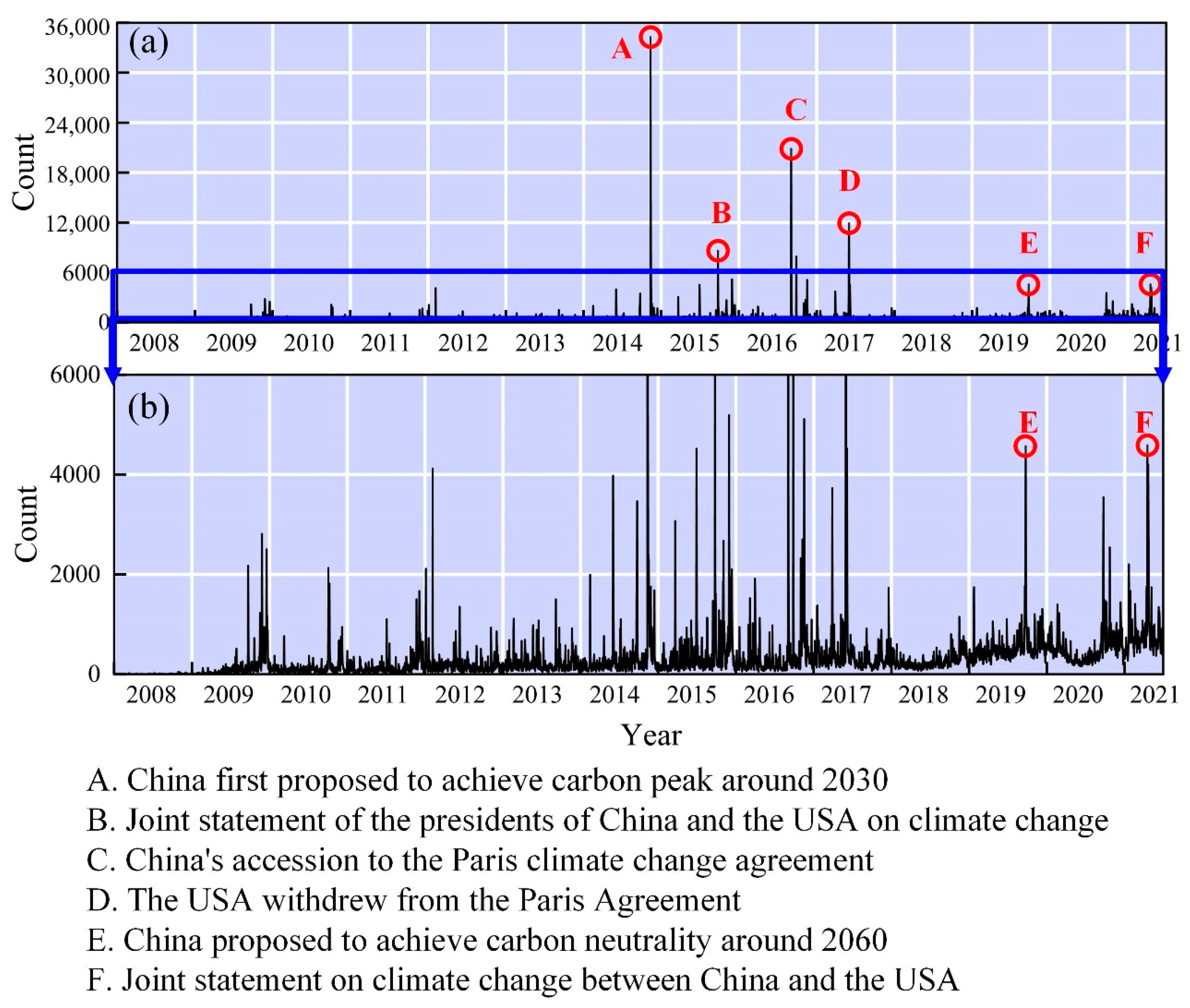
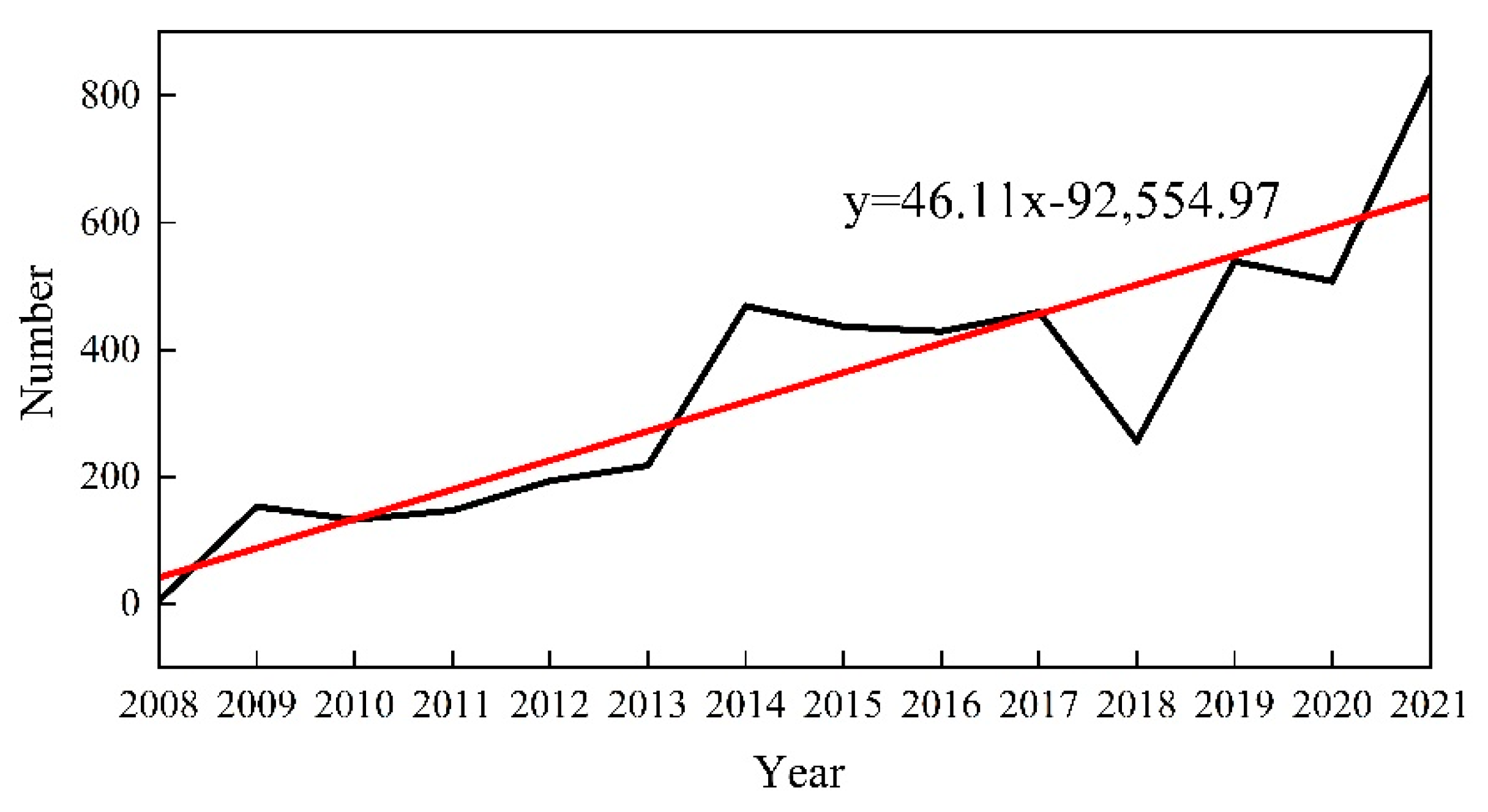
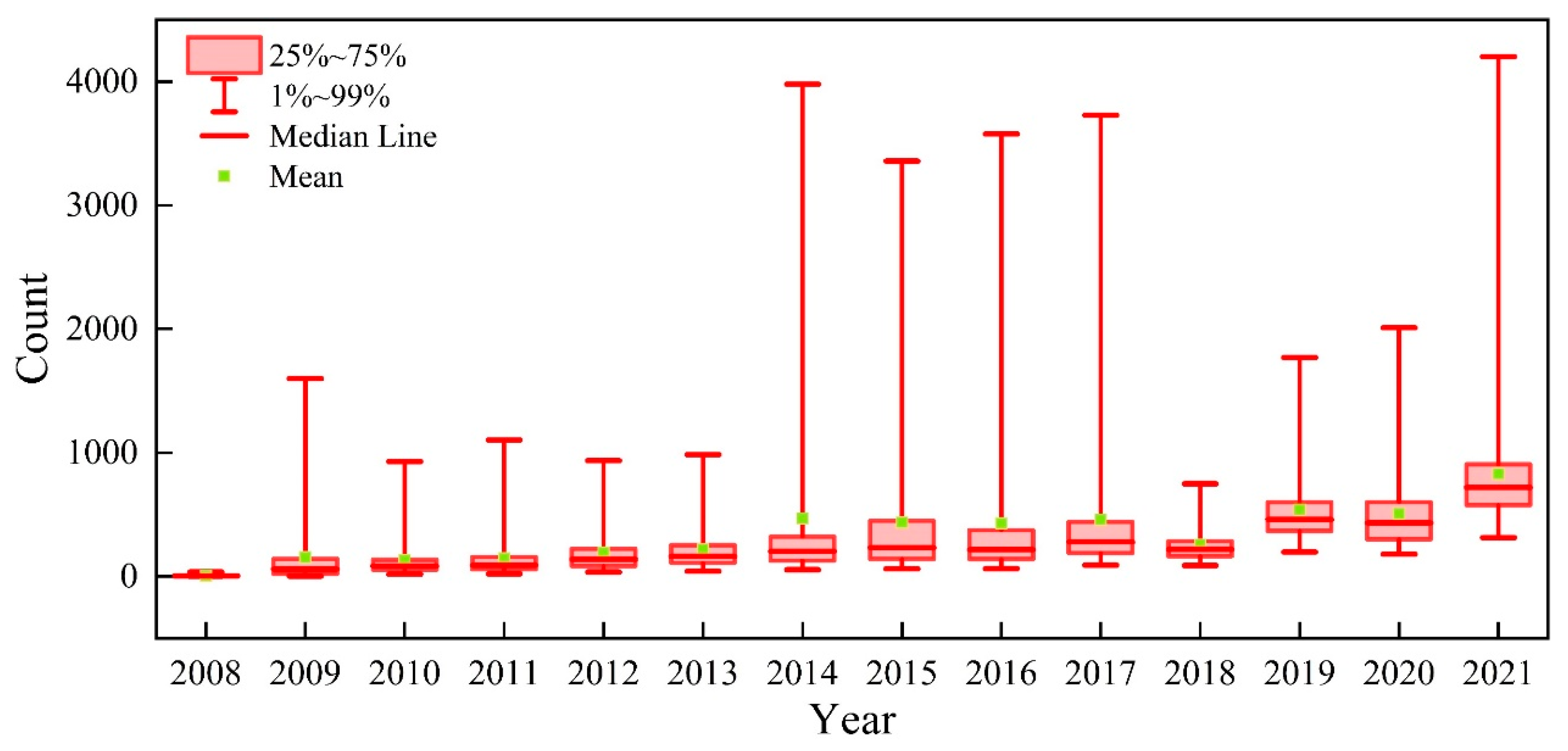
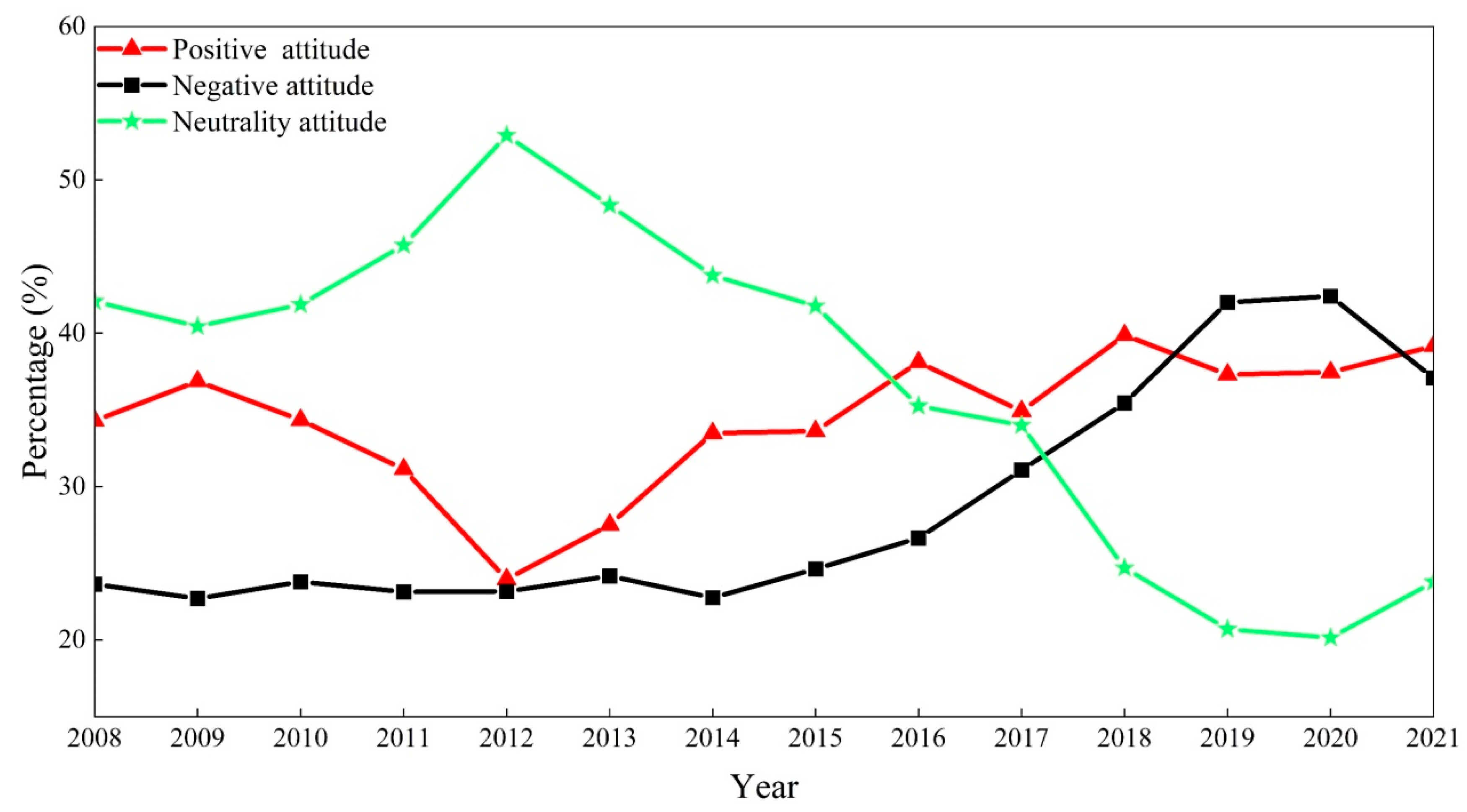
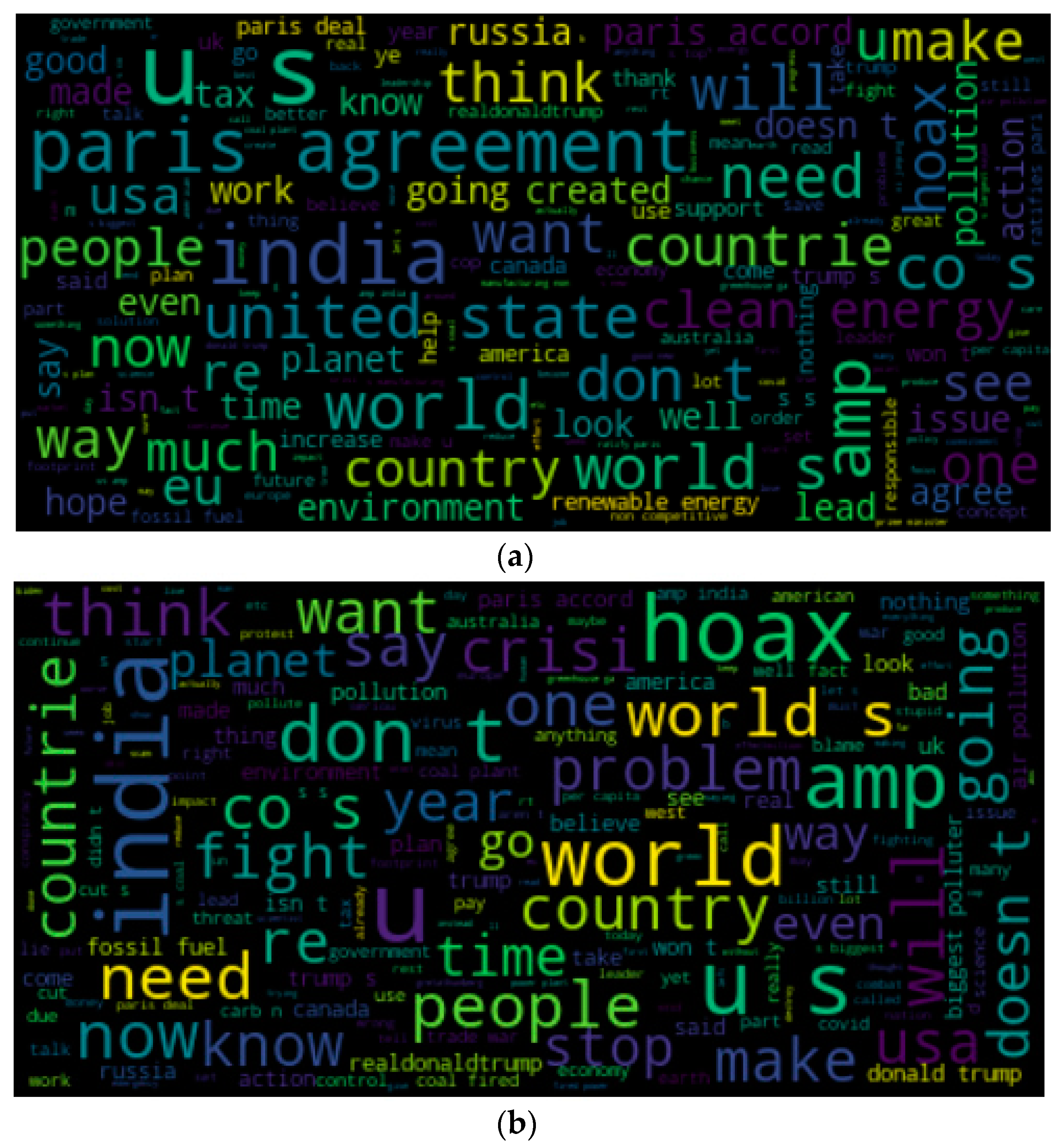

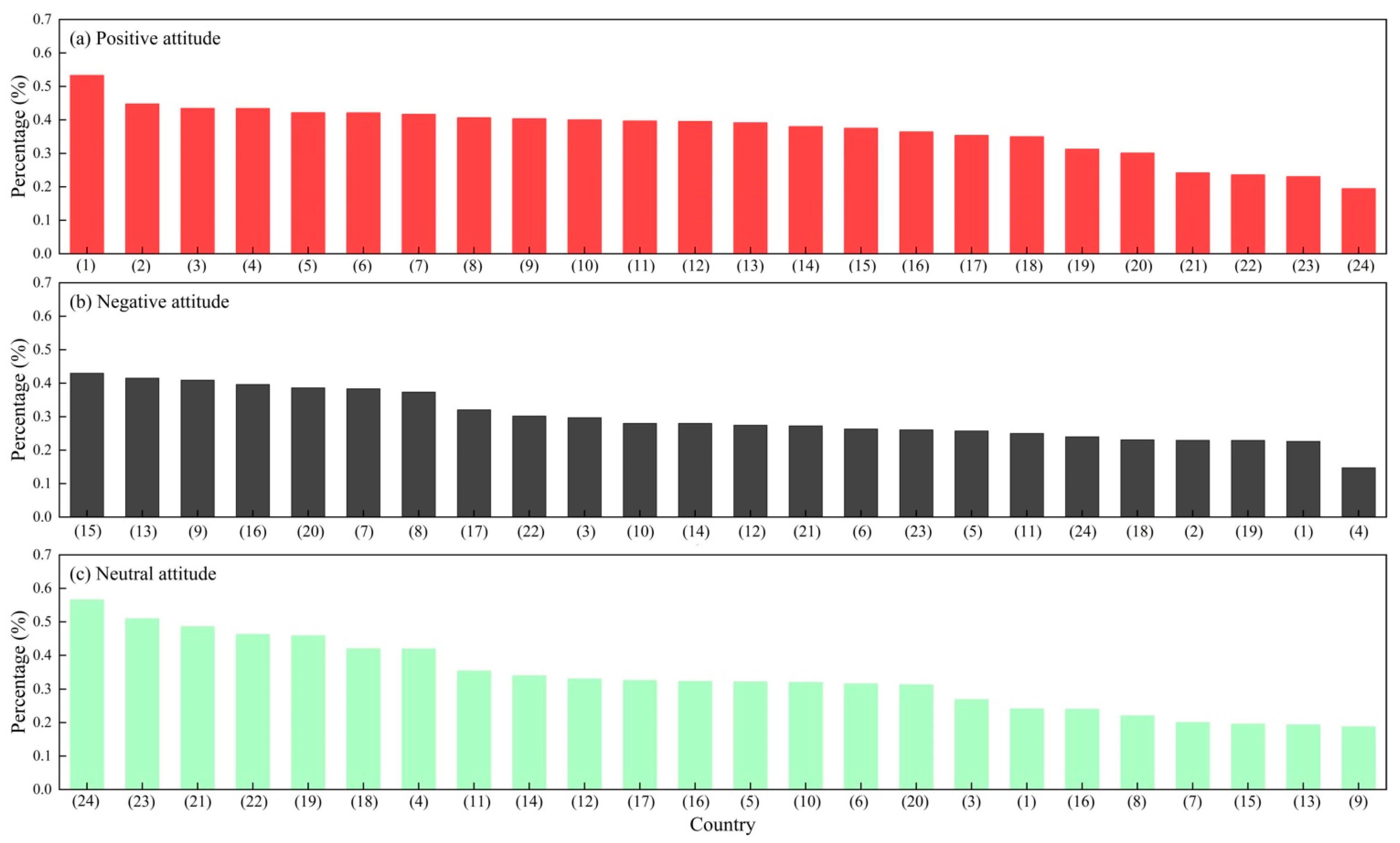
| Twitter Account | User | Creation Time |
|---|---|---|
| @zlj517 | Zhao Lijian (diplomat in Pakistan) | 2010.05 |
| @ChinaEUMission | Mission of the People’s Republic of China to the European Union | 2013.09 |
| @ChinaEmbOttawa | Embassy of the People’s Republic of China in Canada | 2014.06 |
| @Chinamission2un | Permanent Mission of the People’s Republic of China to the United Nations | 2015.04 |
| @ChinaMissionGva | Permanent Mission of the People’s Republic of China to the United Nations at Geneva and Other International Organizations in Switzerland | 2015.05 |
| @CathayPak | Embassy of the People’s Republic of China in the Islamic Republic of Pakistan | 2015.09 |
| @Chinaembmanila | Embassy of the People’s Republic of China in the Republic of the Philippines | 2017.02 |
| @ChinaConsulate | Consulate General of the People’s Republic of China in Chicago | 2017.02 |
| @weiasecas | Wei Qiang (ambassador to Panama) | 2017.11 |
| @ChinaEmSlovenia | Embassy of the People’s Republic of China in the Republic of Slovenia | 2017.12 |
| @China_Amb_India | Luo Zhaohui (ambassador to India) | 2017.12 |
| @ChineseEmb_Uga | Embassy of the People’s Republic of China in the Republic of Uganda | 2018.01 |
| @ChineseZimbabwe | Embassy of the People’s Republic of China in the Republic of Zimbabwe | 2018.09 |
| Count | Coef. | St.Err. | t-Value | p-Value | [95% Conf | Interval] | Sig. |
|---|---|---|---|---|---|---|---|
| original tweets | 6.912 | 2.772 | 2.49 | 0.015 | 1.378 | 12.446 | ** |
| retweet | –0.041 | 0.008 | –5.25 | 0 | –0.057 | –0.026 | *** |
| reply | –2.397 | 0.697 | –3.44 | 0.001 | –3.788 | –1.005 | *** |
| like | 0.039 | 0.037 | 1.07 | 0.288 | –0.034 | 0.113 | |
| quote | 9.904 | 2.185 | 4.53 | 0 | 5.541 | 14.268 | *** |
| Count | Coef. | St.Err. | t-Value | p-Value | [95% Conf | Interval] | Sig. |
|---|---|---|---|---|---|---|---|
| original tweets | 2.686 | 1.006 | 2.67 | 0.01 | 0.678 | 4.694 | *** |
| retweet | −0.017 | 0.003 | −5.44 | 0 | −0.023 | −0.011 | *** |
| reply | −0.877 | 0.305 | −2.88 | 0.005 | −1.485 | −0.269 | *** |
| like | 0.009 | 0.017 | 0.54 | 0.591 | −0.025 | 0.044 | |
| quote | 3.808 | 0.919 | 4.14 | 0 | 1.972 | 5.643 | *** |
| Count | Coef. | St.Err. | t-Value | p-Value | [95% Conf | Interval] | Sig. |
|---|---|---|---|---|---|---|---|
| original tweets | 1.452 | 0.943 | 0 1.54 | 0.128 | −0.43 | 3.335 | |
| retweet | −0.011 | 0.003 | −4.33 | 0 | −0.016 | −0.006 | *** |
| reply | −0.893 | 0.219 | −4.07 | 0 | −1.331 | −0.455 | *** |
| like | 0.015 | 0.013 | 1.18 | 0.241 | −0.01 | 0.04 | |
| quote | 3.424 | 0.755 | 4.54 | 0 | 1.918 | 4.931 | *** |
| Count | Coef. | St.Err. | t-Value | p-Value | [95% Conf | Interval] |
|---|---|---|---|---|---|---|
| original tweets | 2.774 | 0.975 | 2.84 | 0.006 | 0.827 | 4.721 |
| retweet | −0.014 | 0.002 | −5.61 | 0 | −0.018 | −0.009 |
| reply | −0.627 | 0.198 | −3.17 | 0.002 | −1.021 | −0.232 |
| like | 0.015 | 0.009 | 1.75 | 0.085 | −0.002 | 0.033 |
| quote | 2.673 | 0.587 | 4.55 | 0 | 1.5 | 3.845 |
Publisher’s Note: MDPI stays neutral with regard to jurisdictional claims in published maps and institutional affiliations. |
© 2021 by the authors. Licensee MDPI, Basel, Switzerland. This article is an open access article distributed under the terms and conditions of the Creative Commons Attribution (CC BY) license (https://creativecommons.org/licenses/by/4.0/).
Share and Cite
Xiang, N.; Wang, L.; Zhong, S.; Zheng, C.; Wang, B.; Qu, Q. How Does the World View China’s Carbon Policy? A Sentiment Analysis on Twitter Data. Energies 2021, 14, 7782. https://doi.org/10.3390/en14227782
Xiang N, Wang L, Zhong S, Zheng C, Wang B, Qu Q. How Does the World View China’s Carbon Policy? A Sentiment Analysis on Twitter Data. Energies. 2021; 14(22):7782. https://doi.org/10.3390/en14227782
Chicago/Turabian StyleXiang, Ning, Limao Wang, Shuai Zhong, Chen Zheng, Bo Wang, and Qiushi Qu. 2021. "How Does the World View China’s Carbon Policy? A Sentiment Analysis on Twitter Data" Energies 14, no. 22: 7782. https://doi.org/10.3390/en14227782
APA StyleXiang, N., Wang, L., Zhong, S., Zheng, C., Wang, B., & Qu, Q. (2021). How Does the World View China’s Carbon Policy? A Sentiment Analysis on Twitter Data. Energies, 14(22), 7782. https://doi.org/10.3390/en14227782








